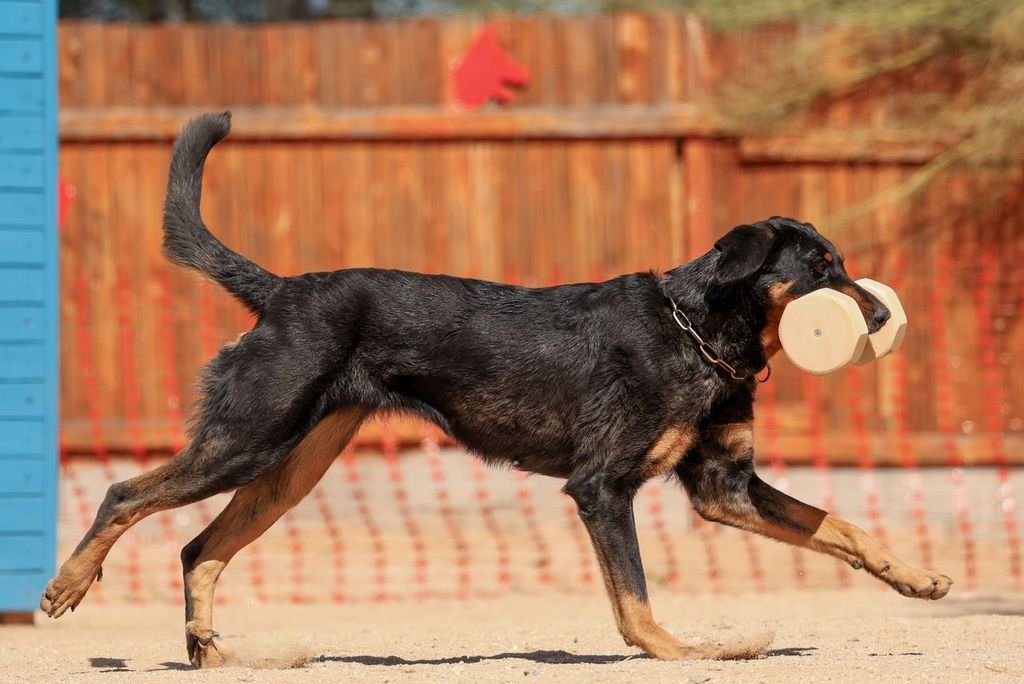
The Beauceron
1. Appearance:
Size: The Beauceron is a large breed, typically standing 24-27 inches (61-69 cm) tall at the shoulder and weighing between 70-110 pounds (32-50 kg).
Coat: They have a short, dense coat that is primarily black and tan, with distinctive tan markings on the legs, face, and under the tail. Some Beaucerons can have a blue or merle coat pattern.
Build: They are muscular and athletic, designed for agility and endurance, which aids in their herding and working tasks.
2. Temperament:
Intelligent: Beaucerons are highly intelligent dogs, making them quick learners. This makes them excellent candidates for training in various disciplines, including obedience, protection, and agility.
Loyal and Protective: They are deeply loyal to their families and can be protective, making them excellent guard dogs. However, this trait requires proper training to ensure they don't become overly territorial or aggressive.
Independent: As a working breed, Beaucerons have an independent streak. This means they can think for themselves, which is a great trait in a working dog but may require an experienced owner to channel that independence correctly.
Energetic: These dogs have a high energy level, so they require regular exercise and mental stimulation. Without proper outlets, they may become bored and develop behavioral problems.
3. Health:
Beaucerons are generally a healthy breed, but like many larger dogs, they can be prone to certain health issues, including:
Hip Dysplasia: A common issue in larger breeds, where the hip joint doesn't develop properly, leading to pain and potential mobility issues.
Elbow Dysplasia: Another joint issue that can cause pain and arthritis.
Dilated Cardiomyopathy: A condition that affects the heart, causing it to become enlarged and less efficient at pumping blood.
Eyes
Routine vet check-ups and a healthy diet can help manage these risks. Regular exercise is also important for maintaining joint health.
4. Training and Socialization:
Training: The Beauceron is highly trainable but needs an experienced handler. They are eager to please but can also be independent, so consistency and clear leadership are key.
Socialization: Early socialization is essential for a Beauceron to ensure they are well-adjusted and comfortable around other animals, people, and new environments. Without this, they can become overly protective or shy.
Mental Stimulation: As a working dog, the Beauceron thrives on having a "job" to do. Training in agility, obedience, or even participating in dog sports can be great outlets for their energy and intelligence.
5. Common Working Abilities:
Herding: Traditionally, the Beauceron was used to herd sheep and cattle. They have strong herding instincts and are capable of managing large groups of animals.
Guarding: Their natural protective instincts make them great guard dogs, both for property and livestock.
Police and Military Work: Some Beaucerons have been trained in police and military roles due to their agility, intelligence, and fearless nature.
Search and Rescue: Their keen senses and trainability also make them effective in search and rescue work.

Ideal Home for a Beauceron
Active Families: Due to their higher energy, Beaucerons do best in homes where they can get plenty of exercise and mental stimulation. They are not well-suited for apartment living unless they have an active lifestyle.
Experienced Dog Owners: Because of their independent nature and strong working instincts, they are best suited to experienced dog owners who can provide firm, consistent training and leadership.
Space to Run: Ideally, they should have access to a large, secure yard or be taken on regular runs and walks.






